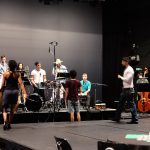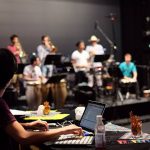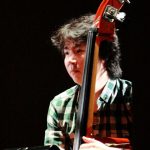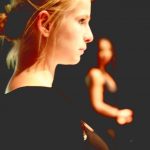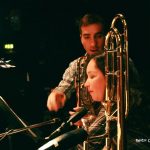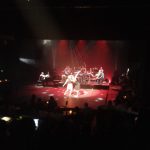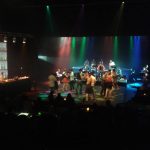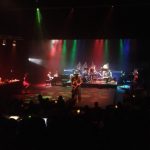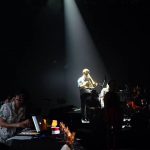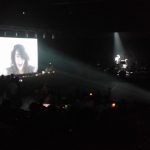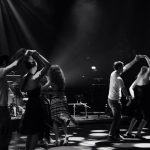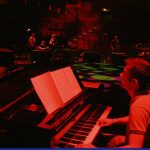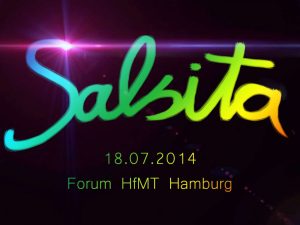Salsita is a multimedia show inspired by one of the most famous Latin American music style: La
Salsa!
It is a project that certainly catches the attention of an international public through the
merger between Latin American popular culture and different techniques of contemporary art. A
bar, music, dance, video, theater and technology applied to art, all gathered under one roof to
achieve a more meaningful and enriching experience. Although conceived as a complete show,
of about an hour, the program can be divided into 8 parts:
The party has already started
Lights, Bar, the Dj and some dancers are waiting for the
public when they come in. The audience have time to go for a drink, look for a place and even
try they dance moves.
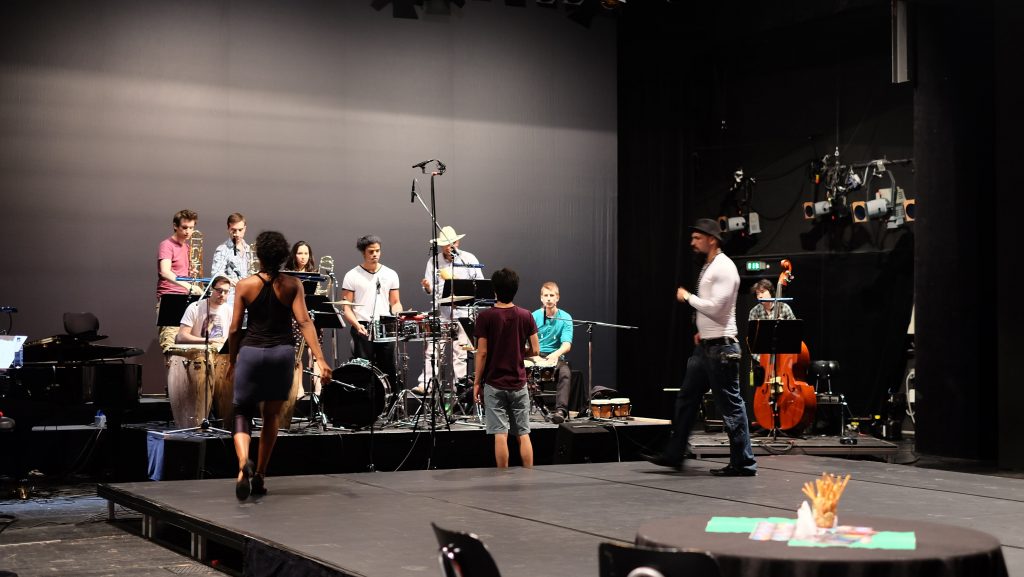
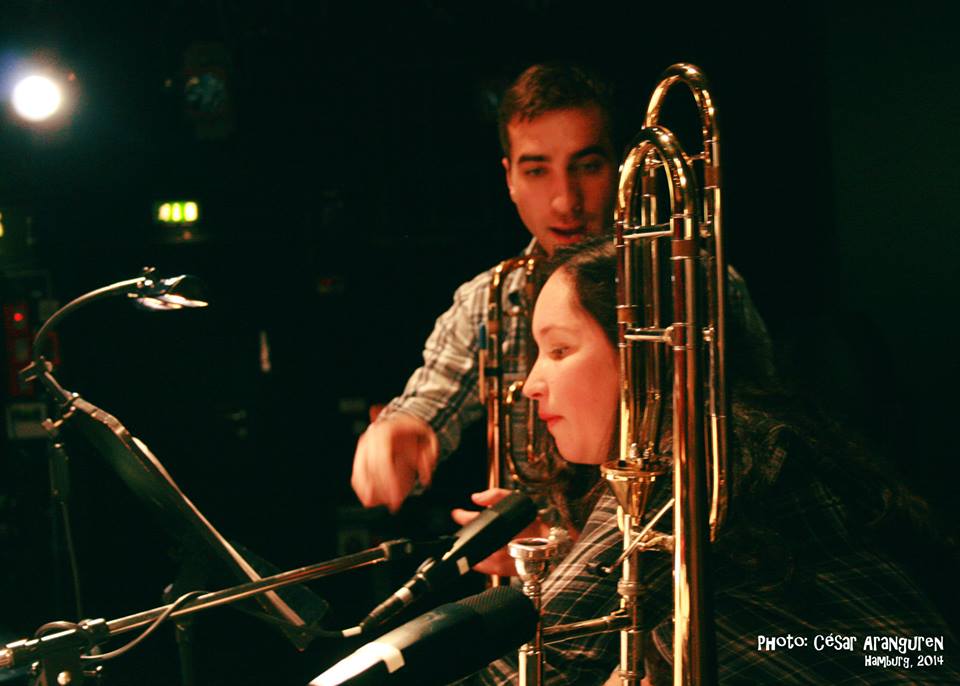
“What is Salsa?” (moderator and musicians)
Dynamic introduction of the instruments and
the different musical influences of Salsa. This moment is inspired by the presentations made by
Izzy Sanabria for the Fania in the 70’s.
Salsita (dancers, musicians and live electronics)
Fun and romance are introduced through
the dance. Both delicate body contact and fast twists will make the public want to move from
their places.
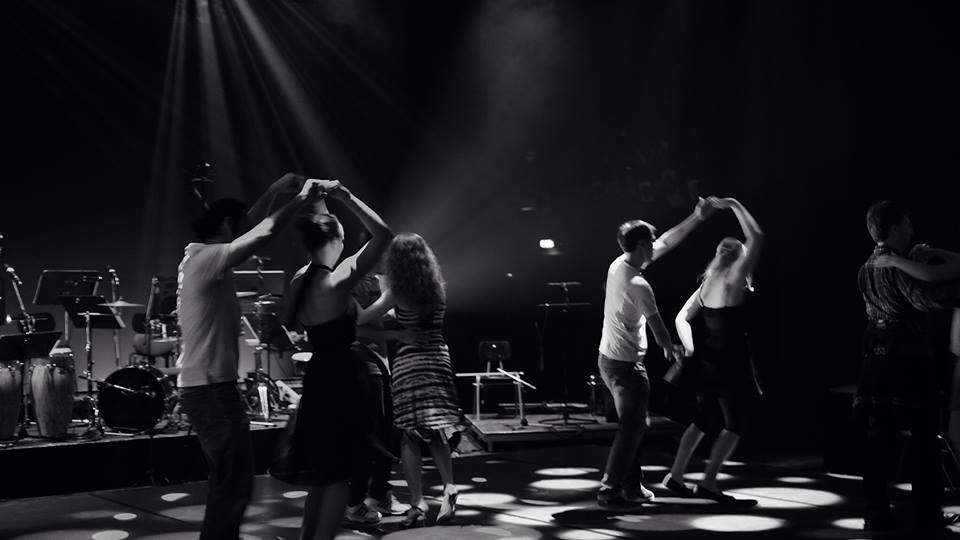
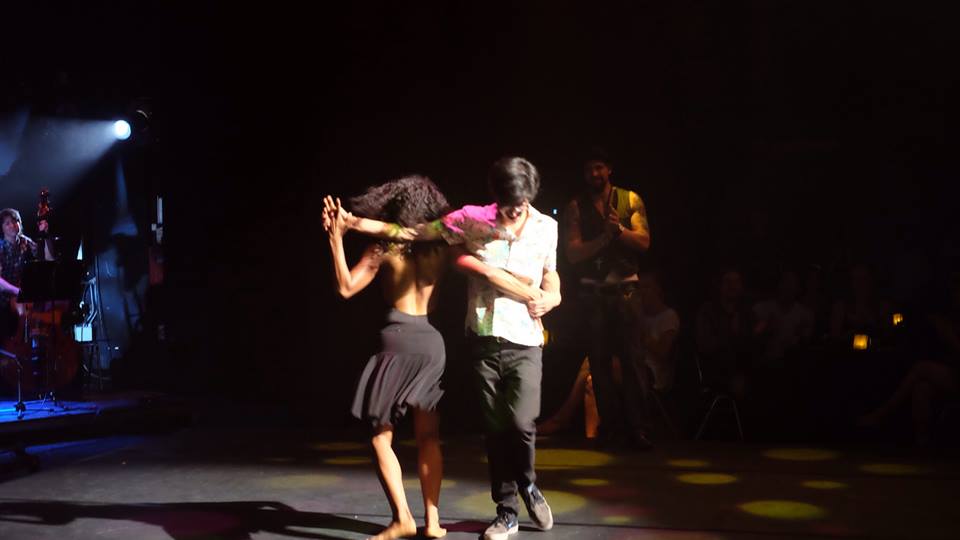
So far So close (dancer, bass, conga, trumpet and piano)
A man dances with the memories
of his beloved. The theme of immigration is present since the beginning of the Salsa.
Here we dance the tragedy (video, trombone and live electronics)
Dynamic introduction of the instruments and
the different musical influences of Salsa. This moment is inspired by the presentations made by
Izzy Sanabria for the Fania in the 70’s.
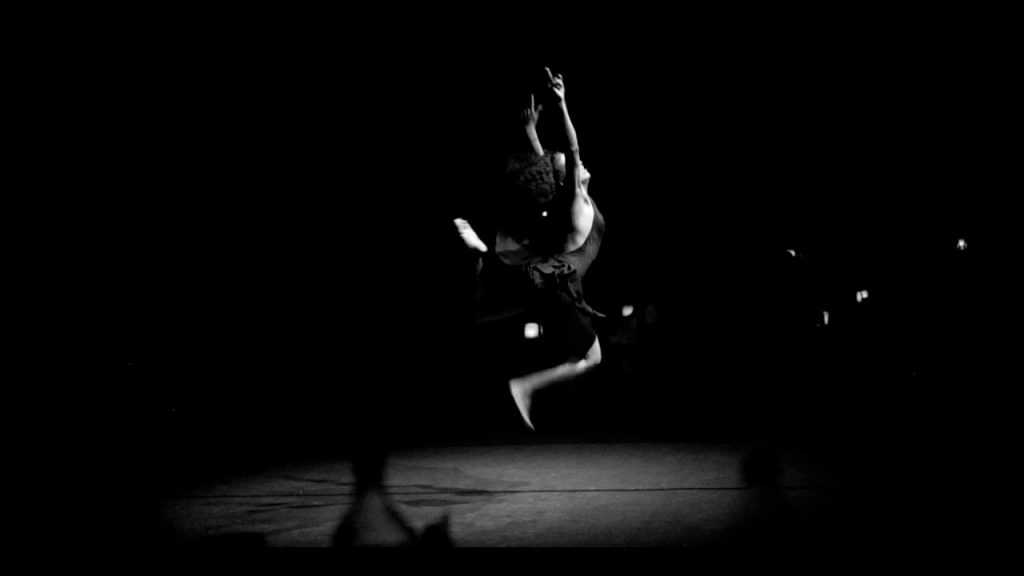

The light-footed messenger (dancer and electronics)
A journey from the beginnings of Salsa
up to what could be its future. One of the most intense moments of the night, where the African
influence in Salsa becomes visible.
The Subsidiary of Heaven (timbales and live electronics)
Mira vé! ois! vení! A tribute to Cali,
city considered the world capital of salsa. In this piece is possible to listen recordings made in
the city center and a virtuoso Timbales solo.
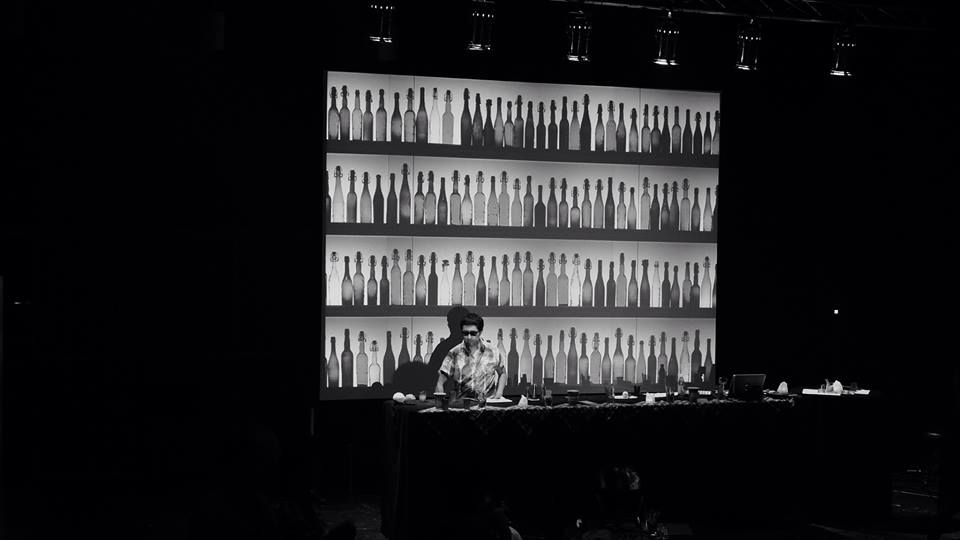

The party never ends! (moderator, musicians and dancers)
Presentation of the band and
connection to the party where the audience are invited to continue dancing.
G A L L E R Y
"Salsita" Looking for an (Inter)personal Experience
Prologue
This document is the memory of the research conducted during the creation of Salsita, a project that culminated with a concert in July 2014 as part of the completion of my multimedia composition master studies. The results of this research are presented in this text in a way I consider meets the nature and creation of the project, as well as my current artistic inclinations.
Carlos Andrés Rico
YK
Rain. The day was dark and cold, but they really wanted to go out for a beer. It was Friday night anyway. As usual, the first to arrive was Andrés. 15 minutes later, Carlos. After a short hug they entered the YM, a small red light bar that had become their meeting place a couple of years ago. They ordered two beers and two small Mexikaner (a mixture of vodka, tomato juice and tabasco). Drinks in hand, they sat down at the only table available and started talking about the same issues as usual; the concert last week, the weather, work, nothing that really matters.
Half an hour later two girls entered the bar. Without finding a better place to sit, they came to the same table where Andrés and Carlos were talking. There, two chairs were available.
– Well? Are you going to get elegante tonight? -Andrés asked Carlos-.
Andrés knew that with this word he could always convince Carlos to make contact with a group of girls, even if they both knew beforehand that he was going to be rejected.
– Wait -was all Carlos said. His mouth was still in the almost empty beer glass-.</span>
The wait was not too long. After a short silence, Carlos drank a sip from what was left in the small glass and interrupted the girls abruptly. They were talking non stop since they had come into the bar.
– Want to drink a Mexikaner with us? -Carlos asked nervously, letting them know that he was going to the bar. The girls looked at each other and decided telepathically-.
– Why not? answered the one with short hair. She didn’t seem too sure-.
Without saying anymore, Carlos went to the bar and returned five minutes later with the first round.
The conversation started as usual; what do you do? where do you come from? really? jada jada jada. All that and some practical jokes. Lisa studied business administration and Andrea, the one with short hair, sociology. Both from germany. Slowly the talk focused on the kind of music that Andrés and Carlos do.
– It’s like classical music but made today- Carlos said. He always gives the same answer when someone asks what kind of music he writes-. It can be a composition for solo piano or for orchestra.
– So you have to learn all the instruments? -Lisa asked surprised-.
– No, we mainly use the computer as our music instrument. -Andrés replied-.
– So you make electronic music. -Lisa said-.
– Yes, but not what you usually hear on the radio -Andrés explained-. Something a little bit more experimental.
– Ahhh I see -said Andrea, happy to have solved the enigma-. And you really like this experimental music or whatever it’s called?
Carlos and Andrés laughed at the same time because of the displeasured tone of the question. At that moment arrived by surprise Maria, André’s girlfriend. While the couple greeted each other with some cheesy gestures, Carlos prepared the answer and then addressed it to Andrea.
– I really don’t often wonder whether I like it or not. I like composing experimental music, I know that, but I really don’t listen to it often.
– So what is your favorite music?
– Difficult question.
– Ok, who is your favorite singer?
– Even more difficult.
– Well, but what do you listen to normally?
– It depends on the situation. For example, if I have to clean my room I love hearing Vallenato, a popular folk music of Colombia. Or when I cook I love to hear songs that I can sing, some rock in Spanish; Café Tacuba, Robi Draco Rosa, something like that.
– And for dancing?
– For dancing, Salsa!
MARCH 2013 – Step No.1: Acceptance
Be honest: Contemporary music is reduced to very few moments in my life, mainly concerts, and mainly concerts from friends or acquaintances. That time when I listened with pleasure all Lutoslawski’s symphonies or Grisey’s “Les Espaces Acoustiques” seems to be over. Now all I hear are some of my favorite works when I’m looking for inspiration for a new composition.
Why should I write music following styles which I do not feel truly identified with?
Since some time I want the music I compose to turn into a reflection of my experiences, my thoughts and my desires. A reflection of who I am as a musician, but most of all as a human being.
I hope that if I look for inspiration in the music I really like and enjoy, I will find new ways of composing.
How can I transmit local concepts regardless the background of the listener?
I do not want to copy, I want to create new sounds, new styles. I want to show my curiosity. I wish my style turn into a kind of popular music with influences of contemporary music, not vice versa. The material for study and work instead of coming from modern composers, come from the traditions and folkways, not only from Latin American countries but worldwide. Perhaps the critics in some years could find a “nice” name for this style.
Wikipedia in 80 years: Carlos Andrés Rico (Bogotá, April 28, 1986 -?) was a Colombian composer associated with the “Popular Vanguardism” or “Contemporary Popular Music” musical style originated in Hamburg during the first decades of XXI century.
Do it Don’t do it Do it Don’t do it Do it Don’t do it Do it do it Don’t Do it Do It Don’t Do it do it do it do it do it do it don’t do it yes do it doitdoitdoitdoit! I’LL DO IT!
LAUSANNE, BY THE LAKE – Lets get the party started
– What do you wanna do?
– I want to dance. Shall we dance?
– What do you wanna do in your graduation concert?
– A Salsa Party! A show! with dancers and all… Shall we dance?
– Salsa?
– Salsa!
musicdancepassionromancebodycontactseductionloveheartbreakspitenostalgialotsofnostalgiahectorlavoethesingerfromsingerslatinamericacubaclaverubenbladesunitedlatinamericaintegrationfamilytraditionafricadrumswindscaribbeansaborrrmovem
– I think you’ll have to filter a little bit.
– entvirtuositydescargapartyrumba45rpmsweatalcoholdrugsfunmusicdancepassionlove and why should I filter a little bit? That’s what Salsa is.
– You missed withoutsalsathereisnoheaven and how do you want to explain all this?
– There are different ways to transmit different ideas; music, video, dance, text and technology applied to art. Besides, the possibilities of mixing these medias, depending on the concept you are working with.
– Actually I can not believe that in a one-hour concert you can explain that much.
– You said it right; it is a concert, maybe more like a multimedia concert, but not a seminar about salsa. Also I think you’re underestimating.
– The audience?
– The audience.
– At least I don’t think that a public that doesn’t have experience with Salsa can learn so fast a speech as varied as your salsa ismusicdancesonmontunopianotumbaowe’replayinglikebeastsreligionfan
aticismalifestyle
– I’ll not ask them to learn the history of salsa, neither the musical structure. Much less how to dance. I just wish that they can immerse into it, even if it’s just for a few minutes. That for a moment they experience the same fascination that comes over me when I hear the drums striking, when I listen how the trombones pass through with their bestial sound or the voice of the great singers with their melodies that go straight to the soul. I hope they realize that within a popular genre like Salsa you can find the history of mankind, an entire culture, and how this music can unite continents and countries just by telling the story of just one person. I want to let them see that popular music, no matter if it’s Salsa, Cumbia, Tango, Samba, Chicha or Bambuco, is a reflection of the society that carries it, and it can be useful as a tool to understand, criticize and improve this society. It generates cultural identity, racial identity, individual identity, becomes a place of equality; everyone singing, dancing, having fun, getting close, getting far. There is no discrimination! A place to forget the difficulties and injustices. A dream! See, that’s what Salsa or popular mu…
– Shall we dance?
MUSIC ANTHROPOLOGY – Music functions
For Alan Merriam (1964), ethnomusicologist, music is to be studied from the relation it has with society and understood as human behavior. His studies are recurrent regarding his worry for music to be understood as a mean of communication among cultures, as a physical and social behavior, and as a way towards conceptual knowledge structured by a group. Likewise, it is also necessary to understand the different uses and functions music can have in a society; entertainment, aesthetic enjoyment, contribution to social integration, and expression of emotions are just some of the functions proposed by Merriam.
14 APRIL 2013, HAMBURG – The color is back
Today began the third semester of the master, and after the first composition class with Manfred, in which I shared for the first time my new idea, it became already clear that if I really want to work with Salsa as a reference style for my graduation project, I will have to study it very thoroughly. Everything must be relevant, not only the musical characteristics, but also the various aspects related to it. Everything is possible; history, differences between countries, sub genres, dance movements, etc.
This will require the use of different methods to help me enter this world. Analyze scores, talk to experts, listen carefully to the music and even learn to play basic patterns on the bass, piano and percussion, are some of the methods that come to mind at this moment.
I’m really excited about this new project. I feel that a new phase in my life is beginning, and I’m full of optimism. It must be the spring.
TWO COFFEES AND ONE CIGARETTE – Master of ceremonies
– And why not use a kind of presenter to explain the extra-musical concepts?
– With presenter you mean a master of ceremonies?
– Yup! host, hostess, master of ceremonies, call it however you want. It can be a singer, an actor or a friend who can dance and speak good german so that people will understand. You all Latinos carry the rhythm in the blood.
– That’s not true. For me it was very difficult and I had to try my best. I don’t know, It doesn’t sound like your idea is going to work. A master of ceremony will carry a strong theatrical role and may attract too much attention from the audience. Even distract them from the really important concepts.
– It doesn’t necessarily have to have an important story with plot and resolution. Nor have to duplicate or repeat what is already understood from the music and the dancing. Not necessarily have to be the star of the night. But yes, it should have it’s own life. Think of it more like a tool to put the audience in context. One way to explain issues and concepts that are for many unknown.
– And what if this role is done by video or voice recordings?
– It is also a possibility, although electronics wouldn’t achieve the same effect as a person on the stage, if what you want is to reproduce a salsa party in Bogotá.
– I don’t know. I’ll have to think about it.
MR. SALSA – Was ist Salsa? (concert introduction for host and salsa orchestra)
The Master of Ceremonies of the Fania All-Stars Israel Sanabria, also known as Izzy “Dizzy” Sanabria, or under the pseudonym Mr. Salsa, often performed a sort of introduction for this legendary orchestra, bringing a touch of live show to the concerts. Something that before the 60’s was not usual in the latin music groups, especially when presented at stages in North America.
To open the night, Sanabria used a “pedagogical” speech in order to explain the audience what Salsa is. This speech set out the various components of the Salsa orchestra and prepared the public for a more analytical listening.
Was ist Salsa? Salsa es sabor Salsa is flavour and spice Salsa ist die Seele Lateinamerikas Salsa ist ritmo, Rhythmus
Es begann in Afrika con LA CONGA Haut auf Holz. EL BONGO Das Fundament von Salsa LA CLAVE
Der Rhythmus aus Afrika kam in die Karibik nach Puerto Rico, Santo Domingo, Cuba, Mexico, Colombia, Sudamérica, und traf hier Lo Indio. EL TIMBAL EL GUIRO
Und jetzt der Herzschlag des Salsa el corazón de la salsa der Seele. DER BASS
Aus Europa the 88s: EL PIANO
Die Söhne und Töchter came to the USA und hier vereinigten sie sich mit einem Einfluss aus der Jazzmusik. New York, Los Angeles. American Salsa. THE BRASS.
Das ist Salsa!
SATURDAY NIGHT – I. Salsita (for two dancers, percussion, contrabass and live electronics)
Full bar. The best moment of the night. Everyone is sweating. He is alone, waiting for some miracle to happen. Waiting for somebody who wants to dance the rest of the night with him. He is very lucky. The miracle arrives and wants to dance. She is also alone, looking for somebody. He follows her with his eyes. She searches at the dance floor, at the tables. She finds him.
She is all flirty and with her eyes and smile invites him to dance. He approaches. She walks away. You don’t get the best things in life so easy, she thinks. He must insist. One two three times. She always walks away. Always with a provocative smile. She plays hard to get, he thinks. He must be more determined. He takes her hand. Doesn’t let her walk away again.
A loud hit and the music stops. Time also. Only two on the dance floor. Everything becomes slow, incr easi ngly slo wer. They get close to each other. They feel at each other. They share the breathing and the heartbeat. The music continues, but is much slower. Each stroke of the percussion takes forever. Its resonance extends throughout the place; is it still Salsa?
They do not speak and however, without saying a word, get to know each other. Their movements are synchronized, as if they had danced a lifetime together. They dance very slowly; Is it still Salsa? They keep feeling each other, but sometimes remember that there is a party going on around them. It is the best moment of the night. They have to give their best! So they give more, and more, and more, and their bodies react with each stroke of the congas, spread like the resonance of the contrabass and shudder at the loud attacks of the electric trombones. Each movement is converted into sound. Their body in music. There is no band but the music continues.
I STILL HEAR IT – Gestalt theory / Law of continuity
Gestalt psychology tries to understand the laws of our ability to acquire and maintain meaningful perceptions in an apparently chaotic world. The central principle of this psychology is that the mind forms a global whole with self-organizing tendencies. This principle maintains that when the human mind (perceptual system) forms a percept or gestalt, the whole has a reality of its own, independent of the parts. In the domain of perception, Gestalt psychologists stipulate that perceptions are the products of complex interactions among various stimuli.
Law of Continuity: The law of continuity states that elements of objects tend to be grouped together, and therefore integrated into perceptual wholes if they are aligned within an object. In cases where there is an intersection between objects, individuals tend to perceive the two objects as a single uninterrupted entity. Stimuli remain distinct even with overlap. This Gestalt law states that learners “tend to continue shapes beyond their ending points”.
FARAWAY, SO CLOSE! – II. Tan Lejos Tan Cerca (for one dancer, trumpet, piano and electric bass)
There is no band, but the music continues and changes. He keeps choosing to be close to her. He wants to possess her. He wants to dance the slowest song with her. She doesn’t choose the same. Her music is another, at a speed that no one can follow. She wants to move. He desires her but she just wants to dance. As if by magic she disappears. He has lost her forever. He knows that a woman who wants to dance can not belong to anyone, only to music.
As if that was his destiny since he came to this country a few years ago, he ends up alone again, desperate to find a love that seems every day further away. He searches at the dance floor, at the tables. Finds it. She has not changed since that afternoon years ago when they parted. She has not changed a thing, but didn’t remains the same. The truth is that everything has changed from that afternoon years ago. She became a memory, sometimes so close and sometimes too far. How good they dance together! They dance the slowest song. The music brings them close, closer and closer, so close as if they were just one.
YOUR LETTERS AND YOUR HANDKERCHIEF – Emigration & Salsa
Here are the memories of my sad love
by which I suffered so much
A bunch of flowers
and a white handkerchief
And because you don’t love me anymore,
I don’t love you anymore
There go your letters
and your handkerchief.
This lyric written by the puerto rican composer Rafael Hernandez, at first sight a typical tragic love history, reaches in a social context a deeper meaning, principally the separation caused by the emigration. The letter is used as a symbol of distance; the handkerchief as a symbol of farewell.
The history of Salsa goes hand in hand with emigration, beginning with the Africans exile to the Americas, than the massive migration of Latinos seeking better opportunities in USA, and culminating with the expansion of Salsa all over the world.
Emigration, now a personal theme, will be the subject of the piece for solo dancer and ensemble. The text of Rafael Hernandez will be the first inspiration; a man dancing with his memories; the memory of his beloved; the memory of the different styles of music he heard years ago at home.
COFFEE SHOP, BAD DAY – Drama or Music?
– I don’t want to tell any story.
– What then? With dancers and actors on stage, for me it could be very easy to imagine a history, even if you don’t want to.
– I know, but I just want to show a part of the vast world that lies behind Salsa. That’s all. No big tragedy, no love history. No Romeo, no Juliet.
– I’m not asking you to be Garcia Marquez. You’ll never be like him.
– There you are right. I’m a musician, not a writer, and my dream is to express myself mainly through music, even if what I want to express comes from a non-musical context.
– I understand that, but indeed there may be a need for a drama, a thread through the different moments. Unless you want to show independent pieces that have no connection to each other.
– Something in the middle. I want an uninterrupted flow throughout the night, but at the same time every moment should work fine individually. Four or five pieces that can be performed separately if it becomes necessary.
– That’s good! If every moment works well by itself, you just have to find the right order to achieve tension and release, highs and downs all Through the night. Then you just have to make some good transitions to join the pieces and find a consistent way to make dancers and performers enter and leave the stage. Easy.
– Easy?
– But I warn you now: if during the whole night there is no drama, nor even a small conflict, the audience is going to get tired of looking for it by themselves. At first you have to take them by the hand, then let them go.
21 OCTOBER 2013, SHANGHAI – It is time to look back
Always the same: checking today my work from past years, I found that there are many similarities in the musical processes, especially at the beginning of each piece. These processes are mainly linear, clear and in some cases they lack of surprise (not to say boring). I think this happens mainly because the musical aspects and the technic had been the most important aspects in my compositions. Expression always in second place or hidden very good. Another reason may be that the use of traditional notation was restricting some of my musical and conceptual ideas.
The piece for timbal and electronics should avoid this linearity, and most of all, should be a chance to expand my limits as composer;
explore new ways of notation;
find a middle point between technic and expression;
ensure that the sonic result really reflects the initial concept of the work;
pum
pu
boom
wu!
ajj
ahhh
ha
ha!
eh
ehhh
deee
ehhh
queee
ves?
puesss
tenés
entendés?
no
sí
bien
a lo bien
bacano
vení
mirá
vos
vas a ver
pilláte
calle
barrio
pelao
calidá
shhhhhhhhhhhhhhhhhhhhhhhhhhhhhhhhhhhhhhhhhhhhhhhhhhhhhhhhhhhhhhhhhhhhhhhhhhhhhhhhhh
22 NOVEMBER 2013, HAMBURG – Composing is fun!
Drums are talking! Good rehearsal, we had some difficulties playing synchronized, but I’m sure under better acoustic circumstances should be no problem.
What I like the most is that I’m finding a new and flexible way of working, in which the performers qualities have an important role throughout the development of the composition. A way that is completely new for me. Somehow it seems that we are working together on this piece; me, as a composer, getting the most out of the qualities of the performer, and Pedro, as a performer, providing his talents to the composition.
So far these are the two points that I would be developing during the next rehearsals and the writing of the piece:
-
Virtuosity and spontaneity from popular music in contemporary music:
When playing a solo, a salsa percussionist can for some moments blur the edges between popular and contemporary music; complex rhythms, odd sonorities, new timbres and the development of the material are a few common characteristics of these quasi-ecstasy moments. It can be that the difference lies in the lack of “long term consciousness” of the performer, getting as result a virtuous improvisation instead of a composition. The moment is gone forever. Now, when you should be able to repeat this ecstasy-moment every time you want, the first obstacle would be notation. Normally, these solo moments come from the performer’s talent rather than the composer’s pen. Note: Giving a composition enough place for the spontaneity of the performer, could help me find the way to a non linear development of the piece.
-
New sounds in popular music.
The evolution of popular and traditional music takes some time. It takes even more time that people accept new elements in a style that for years has not change that much (at least not in the instrumental format). Some experiments have been done, most of them adding complexity to the harmonic and rhythm structures, somehow losing the essence of Salsa. But what would happen if the changes are mainly related to the sonorities and timbres of the instruments, while the other structures remain the same? A fictive evolution of salsa music; salsa played by machines.
LIGHT ON – History
How to compress the history of Salsa in a musical composition?
Origin in Africa; arrival to America; first contact with native culture; evolution into different Afro-Caribbean rhythms; Son, Guaguanco, Cha Cha, Bolero, Guajira; consolidation in the Big Apple; Puertorican Salsa; development into different sub genres; Romantic Salsa; spread and propagation through the world; Orquesta de la Luz and Salsa in Japan; what could be its future with the influence of other music styles and the use of new technology.
22 JANUARY, HAMBURG – In the Laboratory
Today I was in the record studio trying to evoke the ritual music of some african and amerindian tribes: claps, bird whistles, euphoric shouts, rattles of the Andes and some African percussion to bring to life the piece for dancer and fixed media. During the experiments also appeared:
A piano montuno in just intonation
Strong brass hits taken from some jazz standards
A salsa bassline changing slowly and almost imperceptibly
Subtle but stylistically important rhythmic variations
Digitally manipulated percussion sounds
A giant guacharaca moving through the space
A microtonal cowbell
THE LIGHT-FOOTED MESSENGER – IV. La mensajera de los pies ligeros (for dancer and fixed media)
She is not tall nor short, somewhere in between. Maybe more short than tall. Her hair is thick with lots of jet-black curls. Her shoulders are broad and she holds her head high with an air of confidence. Her skin, dark. African heritage. Her experience as a professional dancer gives her security and seems not afraid of experimenting with this music new to her ears.
He is also not tall nor short. Maybe more tall than short (at least in Colombia). His glasses give him an intellectual look, and his smile an air of tranquility. Although he has no experience as a choreographer, he trusts his ideas and believes having a clear picture of what he wants to achieve with this piece.
She tries to understand his character. He tries to explain it the best way possible:
– She’s a flirty woman, but strong and independent. She is looking for a man, but not because she fears loneliness. It’s because men can be useful when she wants to dance. She uses them as a tool to surrender to the music. Nothing else exists. On stage it’s only her and the music. Her music. The sound takes control over her mind and takes her to unknown places. No more control over the body.
Although the words were more abstract than she expected, she does her best attempt to translate those ideas into movements.
The first tries included elements of ancient African dances (full body movements, arms well spread and shoulders very relaxed), stylized steps of salsa and other Latin rhythms (mainly colombian Cumbia), and some behaviors of contemporary dance.
He thought they were on the right way. However, he wanted more theatrical elements.
– Don’t forget that she is not looking for company. No! She seeks the source of the sound, no no no, better; the music is calling her. No man or woman, just sound. Do you hear the drums? Do you hear the birds? It’s mother nature making the music! The history of mankind. Your story.
After these words they turned off some lights to give a more intimate atmosphere to the room and decided to try one more time.
The beginning was better, she seemed more concentrated and followed every sound as if it were connected to a part of her body. Passing the time, the dance became more and more intense; her body started swaying up and down, her flexible arms stretching beyond their limits, her strong legs going high without any effort, and her head started turning around until overflowing everything into a sea of overwhelming euphoria. Body on the floor. Mind in trance.
He could only look at her and tried to follow their movements to understand what she was doing. However in the highest moment of the climax he lost the concentration and started to ask himself why the person who was dancing was not the same one who entered in the room with him.
She ended exhausted on the floor and seemed to need some time to understand where she was and what was she doing. When the music completely stopped it was only possible to feel her breathing, accompanying that satisfying silence you get after a truly intense experience.
BI-MUSICALITY – Personal experience
More pragmatical than Alan Merrian, the ethnomusicologist Mantle Hood created in 1960 the concept of Bi-musicality and musical Bilingualism, suggesting that the best way of penetrating the music belonging to another culture is from inside, by learning how to play it, how to value its learning methods and having general knowledge about people and culture.
13 MARCH, CALI – III. Here we dance the tragedy (video with live trombone and live electronic)
Gladyssss!
I really like Cali! Although it has rained almost every day, it is very warm and you can take nice walks. Even in the evenings! With this temperature, food and women, now I quite understand why Cali is called “the Subsidiary of Heaven”.
Maybe one of the things I like the most is the friendliness of the people. Very often they welcome you with a “hi sweetheart” or with a “hello my love”. Even with the “hey papi” that always makes me smile. Apparently I had forgotten the immediate familiarity that is transmitted in many parts of Colombia. Every time I hear these greetings my heart beats hard!
You can’t imagine all that I’ve learned about Salsa and its relationship with the city. First, something I had never experienced in Bogotá, is that Salsa is music from the neighborhood and represents mainly a social sector with difficulties. You know those lyrics about thieves? or about poor people? Well, that’s not at all the imagination of the composer, it’s a lively reflection of the reality of thousands or millions of people. I think you already know that, but what you don’t know is that these people find in Salsa a relief and an opportunity to succeed. They feel identified and get together under one roof for the sole purpose of enjoying music and dancing. Some of them see it as a professional option! It’s amazing, I never thought that music could mark so much the identity of a city.
You should be here! especially to go dance! although you’d get probably bored… every day I have been busy interviewing people related to salsa; today I talked almost two hours with a music collector and yesterday with the director of an important band. I went also to a dance school for children and youth from families with economic difficulties, and tomorrow I’ll go to another dance school famous because their unique style; Salsa-Ballet!
I’m really excited. All this that I’m telling you, I hope to tell also the audience at my concert. Immediately when I arrive in Bogota, I’m going to start working on a video with images that I made in the dance schools and in the streets with the little camera you gave me last christmas 🙂
See you soon!
Your son that loves you.
Andru.
THE SUBSIDIARY OF HEAVEN – V. La Sucursal del Cielo (for timbal and live electronic)
The heat became more and more unbearable and after a full lunch, with salad, fish soup and fried plantain, to move was not an option. However, it was his last day in the city and he wanted to use it well. He scrambled to his feet with difficulty and decided to walk. He wanted to kill two birds with one stone; wander through downtown and eat a delicious “cholao” as dessert.
He started his tour in the 10th Street, near to the Obrero neighborhood. There he took a moment to hear the cries of the street vendors crammed into a single corner. Peculiar were the accent and the words used by these to attract potential buyers.
After some minutes he continued his tour, now through small streets crowded streets, filled with people tasting the delights of Cali cuisine. Here he devoted himself, curiously, to eavesdrop on small groups of people; they speak loud and fast, interrupting each other constantly. Somehow it made it increasingly difficult to follow conversations. The soundscape was dense and concentrating on just one sound source was not entirely possible. The cocktail party effect wasn’t working.
In a less crowded area, he turned his attention to a more general soundscape; a sort of outdoor nightclub with thousand different music rooms; all radio frequencies. The loud music coming from the most diverse loudspeakers, some of them with an amazing capacity for its condition, changed as he continued advancing down the road:penetrating techno beats, romantic pop melodies, an old son montuno from cuba, bachata guitars, noise,
is that Mozart? the voice of Celia Cruz, tango bandoneon and his cousin the vallenato accordion, noise, cowbell, noise, clave 2-3 pattern, noise, clave 3-2 pattern, silence ,a timbal solo.
Finally, at the Pan American courts, he ordered a Cholado (a delicious mix of shaved ice, fresh tropical fruits and condensed milk) and sat down to enjoy his reward after a long walk in the midday sun.
Eating his dessert in a quieter environment, he thought about the intense conversation he had a couple days before with Alexander Daza about the musical diversity in Cali. Alex tried to explain him, based on his 30 years of experience working as a Dj in bars and clubs, how many music styles have tried to capture the popular music scene in Cali, but none have been able to take the throne of Salsa. Some have done better than others; Vallenato y Bachata, talking about popular genres, and Rock and Electronic Music in styles from abroad. However, although some of these styles have had moments of glory, Salsa has managed to stay on top of Cali music scene for more than 50 years.
“Cali is not only Salsa, but Salsa resists everything”
MULTIMEDIA MAIN CLASS – Resistance
– Do you guys include some kind of resistance in your work?
– Well, for me the use of different languages and slang is very important. I think English, as the leading language in the world, is somehow homogenizing the work of artists with completely different cultural backgrounds. A pity! I think we can get very créatif if wir try to overcome de obstacolele wir finder on the way to expressar eine idėja in languages that are ոչ so vel known.
– I try not to follow the big tendencies. Even the “big” tendencies in contemporary music. I prefer to look for inspiration in traditional cultural expressions (music, dance, literature, paint, craftsmanship), especially those that have been little or nothing explored in contemporary art.
– I just…
– I always…
– sorry. Please go ahead
– no, you were first
– no, you, please
– you
– no, you
– come on guys!
– what?!
– what?!
– what!?
– Ok! I go first: I always try to include aspects about social injustice in my pieces. I know that is difficult to work these issues only with music, and that’s also the reason why I like to work with different media at the same time. Now you, please.
– I just do what I want.
LIVING ROOM, SOFA – How the f*^k?
– What’s your plan? How are you going to put into practice all these ideas? One thing is say and the other is write things down…
– The first thing is to learn how to play montunos.
– To play montuno you don’t need paper.
– But the experience.
– And the musicians who have never played salsa?
– It is my duty to give them all the tools necessary to satisfy the stylistic needs; videos, recordings, methods of interpretation, etc. Even be able to support them personally at the rehearsals.
– Personally I think it will be difficult for them to learn to play salsa in just a few months.
– It depends on the performer. And if the notation is enough clear, there should be no problem.
– Are you going to write everything?
– Everything.
– Everything Everything?
– Not everything. The notation must be flexible; a constant movement between strictly written sections and others where the performer can make his own decisions. However, any of the two variables should be well represented in the paper.
– Do you have an example?
– Yeah. Look.
– That!?
– How do you think I start a composition then?
– I don’t know. With Notes? Lines and points. You know.
– First comes a sketch with the structure; the approximate time of each section, textures, registers and roles of each instrument. Then when the sounds together are very clear in my head, it should not take long to transcribe everything into a very clean nice score full with points and lines.
– And the electronics?
– The electronics are another instrument. Look, here is noise and this RM is for ring modulation.
– Ahh I see.
– Generally, to know if I’m on the correct path, I do experiments with the instruments and the electronics at the same time I’m doing the sketches. Listen.
– ♪♪♪♪♪♪♪♪♪
–
– IT’S TOO LOUD
– Better?
– YES ♪♪♪♪♪♪♪♪♪♪♪
–
– ♪♪♪♪♪♪♪♪♪♪♪♪♪♪
–
– It’s over.
– It’s difficult to know if it’s going to be exactly the same with the real instruments, the real performers, and in the place where the concert will be, but it’s good to have an idea of how the result could be.
14 APRIL, BOGOTÁ – ¡Que viva la música!
Hola Diana!
How is everything??? hope you are enjoying the arrival of spring!
I’m writing to you because recently occurred to me that it would be nice if we develop a sort of character for you. I was reading ¡Que viva la música!, a novel by the Colombian writer Andrés Caicedo, and thought that maybe we could get inspired by the protagonist. The fragment that gave me the idea:
Music, like you know me,
Music, like you encourage me,
you fan me and cover me,
the pact is sealed,
I’m your diffusion,
the one who opens the door and settle the step,
the one who transmit through the valleys the news of your union and your abnormal joy,
the light-footed messenger,
the one who doesn’t rest,
the one with the terrible mission,
take me in your arms when the weakness time comes,
hide me,
find me a shelter until I recover me,
bring me new rhythms for my convalescence,
introduce me to the street with renewed strength in an afternoon of colorful necklaces,
and that my air achieves confusion and lost,
I’ll show and spread your airs,
so they become tragic essence of those
who don’t know me,
those who see me and never forget me.
For the dead.
As you see a woman devoted to dance and music!!! What do you think?
I’ll be back in Hamburg on April 21th. From there we can get more in touch.
I send you a hug from la tierrita!
Carlos
14 APRIL, BOGOTÁ – If she can, me too!
Frau Benedict!
Wie geht’s???
Do you remember that some time ago I mentioned a crazy idea about inviting a Colombian friend to cheer the public at my concert? Well, that friend is you! I was thinking and after being in a couple of salsa concerts, I realized it’s a really important role and must be done by someone with experience on stage. I know it may sound weird, but considering that the concert will take place in Germany, I think your presence, being blonde, blue-eyed, far from having the appearance of the typical Latina, can help the public, mostly non-Latino, to feel identified with what they see and hear. At least a little bit 😉
If I choose the typical Latino male as the presenter, it would be easier to take an external position, where dance and music fall into the category of something exotic. Non-personal. Better said, we will change the “is that they have it in the blood” for “if she can, me too!”.
What do you say? All you have to do is present the orchestra, cheer the audience, talk a little bit about the music (in a mixture of Spanish and German) and of course dance! Easy, right? hehe
Unfortunately there are no budget but Credit Points 😉
I would really like to work with you!
Besos from Bogotá!
Rico
MAY & JUNI 2014 – Almost there
Caucasian tall blonde blue-eyed girl presents a Salsa concert: breaking the habit
They dance as if its still possible to hear the music silence
A good mom teaches her daughter how to dance
A good dancer dances with her daughter on the back
Please! Please dear Life! help me find a male dancer. That’s all I’m asking! Is not too much… Ok, maybe a good trumpeter also. Thank you! xoxo
There something especial about this trumpet. Ja! This trumpet sings! And it sings so well that slowly drowns itself in its own sorrows. Sorrows that we all now share
Chopin at the piano, playing salsa
But this montuno was not like the others: its left hand was so bored of playing always the same as her right sister and decided to do something different. She started to jump from one register to another until she transformed into a sound-color-melody.
Dance rehearsal with Diana and Pablo; text rehearsal with Irene; dramaturgy discussion with Vendula; rehearsal with the bassist; bringing together the percussionists; edit scores; cut the video; improve the Patch; design stage and bar; get stuff for the bar; design program; design advertising; print advertising; reach the limits
“Jack of all trades, master of none” – Jack needs to work more in team!
There are much more than just bottles behind that bar; tragedy and hope
As in the old days, when movies were silent and the trombonist had to improvise to accompany the images and to heighten the drama on screen
A Llama in front of a church. A dancer in front of the Llama.
(The great outdoors) A ritual where everyone participates; the wind, the birds, the snakes, the women, the men; The yelling that spontaneously emerge from excitement
She alone fills the whole place with her breathing. Everyone breathe with her
“but there is no Salsa that comes whole to you,
at the end whips the crying, break the fear
emerge the inexplicable sadness” *¡Que viva la música! Andrés Caicedo
Disaster: As I feared, the most difficult thing to do will be to assemble the different moments. It is not just reading the score, text or learning the choreography, it is
musicians reacting to other musicians, musicians reacting to the actress,
actress reacting to dancers, dancers to dancers,
dancers to musicians,
musicians to dancers,
dancers actress,
actress musicians,
musicians video.
This machine’s dream is to play in a Band, so she asks her friend Pedro, a Cuban percussionist, to play for her. She listens very carefully and learns from him. She even records very short samples of what he does and uses them later, as she plays her own rhythms
This piece is like a living organism: it grows with the time, changes its humor from one day to the other and even sometimes get sick. Hopefully is never going to die
Pedro turns rhythm into melody and sings through his drums. Steals the show
Last Minute: The “surprise interview” plan falls down. Federico is very good talking about salsa history but unfortunately acting is not his strong. And rightly so! A systems engineer who has never acted before
The last straw! Jonas gets sick one day before the concert. I had to light a candle for him
20:
14 on stage
6 on backstage
– Only miss the singers and the group of back vocals doing a choreography. Next time!
And after waiting so long, everything is exactly as it should be: they dance Salsa, they play Salsa, nothing else
Yes! there is applause but the music never stopped
At the bar two Colombian guys, they don’t speak a word of German but they sell all the alcohol before the concert ends
Are we still in Hamburg? Or are we now in Colombia?
The party continues. Full bar. The best moment of the night. Everyone is sweating.
Epilogue
These pages tell real and fictional events occurred (or not) during the spring of 2013 and summer of 2014. They are mainly recapitulation of loose sheets with musical thoughts, distorted memories of wonderful moments and notes to the wind. Here the readers could find the origin and development of the most relevant artistic ideas that were developed during the creation of Salsita, a Multimedia Salsa Party.
This text is an important addition to my recent catalogue of works dedicated to bring music composition and contemporary art to an audience with no preview experience on this subject.
These pages are also a way to thank the people and events that have significantly shaped my life as an artist and world citizen.
Carlos Andrés Rico
Somewhere in the middle of the Atlantic Ocean
13.02.2015
Bibliography & Literature References
Bibliography:
Caicedo, Andrés (1977) Liveforever. Penguin Classics, London.
Cámara de Landa, E. (2004). Etnomusicología. Música Hispana, Textos Manuales. Sociedad Española de Musicologia, Madrid.
Gomez, N. & Jaramillo, J. (2013). Salsa y Cultura Popular en Bogotá. Editorial Pontificia Universidad Javeriana, Bogotá.
Merriam, A.P. (1964). The Anthropology of Music. Northwestern University Press, Illinois.
Murray Schafer R. (1992). A Sound Education. Arcana Editions, Canada.
Quintero Rivera, A. (1998). ¡Salsa, Sabor y Control! Sociología de la música “Tropical”. Siglo Ventiuno Editores, Mexico/España.
Waxer, Lise (2002) Situating Salsa, Global Markets and Local Meanings in Latin Popular music. Routledge, London.
Martignon, H. (2007) Salsa Piano. Hal Leonard Corporation, Cheltenham.
Washburne, C. (2008) Sounding Salsa, Performing Latin Music in New York. Temple University Press, Philadelphia.
Literature References:
Beckett, Samuel (1953). Waiting for Godot. Reclam, Ditzingen.
Cortazar, Julio (1963). Rayuela. Santillana Ediciones Generales, Madrid.
Handke, Peter (1977). Das Gewicht der Welt. Residenz, Salzburg.
Hemingway, Ernest (1952). The Old Man and the See. Arrow Books, London.
Hemingway, Ernest (1952). For Whom the Bell Tolls. Scribner, New York City.
Joyce, James (1939). Finnegans Wake. Wordsworth, Hertfordshire.
Allen J. Christenson traducción (2012) Popol Vuh. Cien del Mundo. Mexico DF.
Looking for an (Inter)Personal Experience
Multimedia Composition Master Final Text (PDF Version)
Carlos Andrés Rico
Text Supervisors – Prof. Dr. Georg Hajdu and Prof. Dr. Manfred Stahnke
Hochschule für Musik und Theater Hamburg, Germany
February 2015
